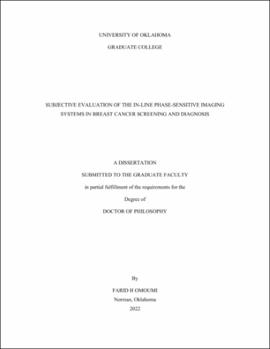| dc.contributor.advisor | Liu, Hong | |
| dc.contributor.author | Omoumi, Farid | |
| dc.date.accessioned | 2022-07-22T19:52:25Z | |
| dc.date.available | 2022-07-22T19:52:25Z | |
| dc.date.issued | 2022-08-04 | |
| dc.identifier.uri | https://hdl.handle.net/11244/335954 | |
| dc.description.abstract | Breast x-ray imaging remains the gold standard screening tool despite the various imaging modalities. The phase-sensitive breast imaging is an evolving technology that may provide higher diagnostic accuracy and potentially reduce the patient radiation dose. Many studies evaluate the performance of the In-line phase-sensitive breast imaging to improve this imaging modality further. Whereas radiologists are the end-users of this imaging technology, the primary goal of this dissertation project is to investigate the performance of human observers in varying conditions for further improvement of the in-line phase-sensitive x-ray imaging system.
A CDMAM phantom and an ACR mammography phantom are used in the observer performance study to compare the high-energy in-line phase-sensitive system with a mid-energy system as an alternative approach to balancing the attenuation-based image contrast with the accuracy of single-projection PAD-base phase-retrieval. Additionally, a series of ROC studies are designed by a contrast-detail phantom to evaluate the diagnostic accuracy of digital breast tomosynthesis (DBT) and the phase-sensitive prototype imaging system (PBT). The area under the ROC curves (AUC) and partial area under the ROC curves (pAUC) are estimated as a figure of merits in the two systems, delivering the equivalent radiation doses. A two-alternative-forced choice (2AFC) study is also designed to determine the preferred image in identifying the suspicious lesions within a heterogeneous pattern acquired by the DBT and PBT systems under an equivalent radiation dose.
The observer performance studies show that the mid-energy system has a potential advantage in providing a relatively higher image quality while the radiation dose is reduced in the mid-energy system compared with a high-energy system. The ROC study shows that the diagnostic accuracy of observers is more significant in the prototype PBT system than in a commercial DBT system, delivering the same radiation dose. The 2AFC study also revealed that observers prefer the PBT system in detecting and distinguishing the conspicuity of tumors in the images with structural noise, and the results were statistically significant.
The dissertation also introduces a mathematical approach for estimating the half-value-layer (HVL) from measured or simulated x-ray spectra. The HVL measurement is expected to be less accurate or experimentally challenging in some clinical equipment or when a quick beam quality evaluation is needed. Additionally, the impact of varying thicknesses of external filtration is subjectively and objectively investigated to evaluate the feasibility of reducing the image acquisition time in a mid-energy system without compromising the observer's performance and detectability. The preliminary results from phase-contrast images suggest that an in-line phase-sensitive system operated at 59 kV shows a comparable image quality with the x-ray beams filtered by 1.3 mm and 2.5 mm-thick aluminum filters. This finding could help shorten the exposure time by 34% in the mid-energy system, where image blurring is a concern due to patient movement in a longer image acquisition time.
In summary, and as expected, the subjective analyses of the in-line phase-sensitive imaging system align with the previous findings. However, the PBT imaging system may benefit from further improvement in image processing algorithms and optimizing the system with the most appropriate x-ray beam quality, considering the acquisition time, breast glandular composition, breast thickness, and different x-ray energies.
Keywords: Phase-sensitive X-ray Imaging, Breast Imaging, Image Quality, Human Observer Performance Study | en_US |
| dc.language | en | en_US |
| dc.subject | Human Observer Performance Study | en_US |
| dc.subject | Breast Imaging | en_US |
| dc.subject | Image Quality | en_US |
| dc.subject | Phase-sensitive X-ray Imaging | en_US |
| dc.title | Subjective Evaluation of the In-Line Phase-Sensitive Imaging Systems in Breast Cancer Screening and Diagnosis | en_US |
| dc.contributor.committeeMember | Siddique, Zahed | |
| dc.contributor.committeeMember | Zheng, Bin | |
| dc.contributor.committeeMember | Havlicek, Joseph | |
| dc.contributor.committeeMember | Qiu, Yuchen | |
| dc.date.manuscript | 2022-07-20 | |
| dc.thesis.degree | Ph.D. | en_US |
| ou.group | Gallogly College of Engineering::School of Electrical and Computer Engineering | en_US |
| shareok.orcid | 0000-0003-1956-0879 | en_US |
